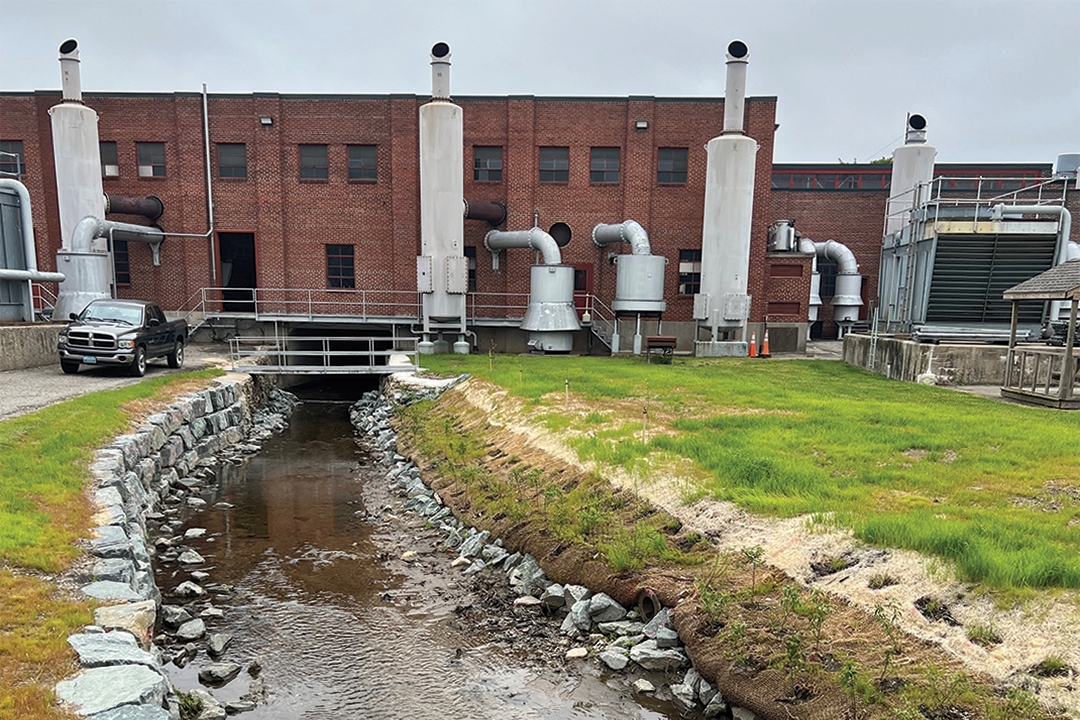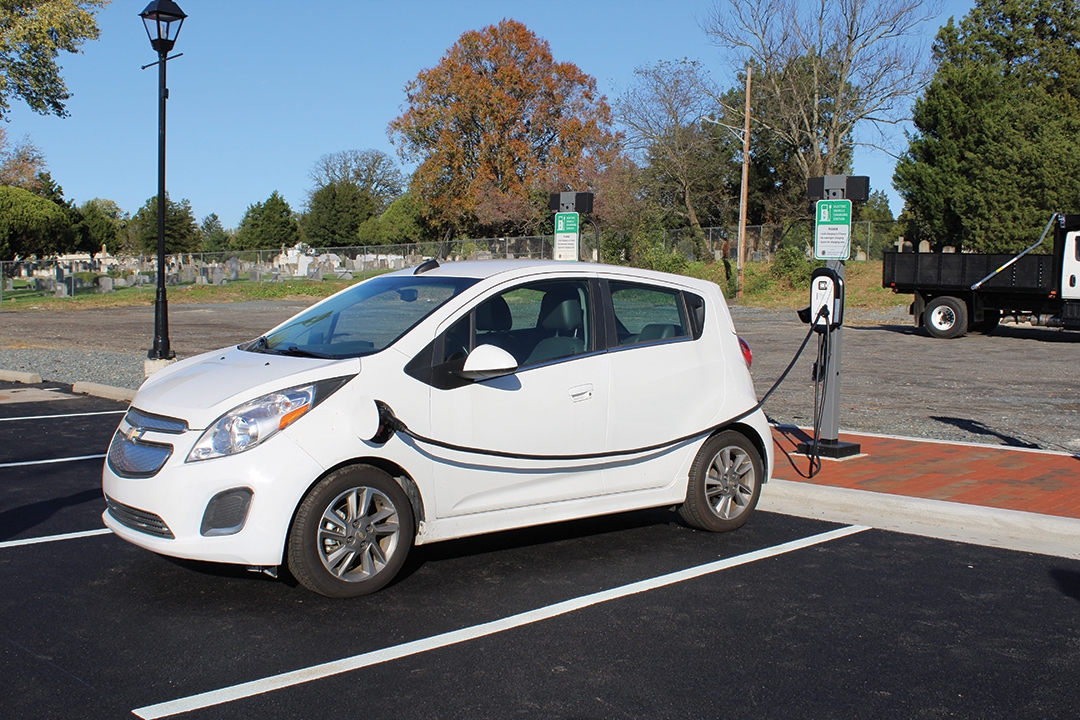ENVIRONMENTAL STEWARDSHIP
Solar Array
Perhaps the biggest effort to offset greenhouse gas emissions was the installation of the 2MW solar field at Easton’s Sustainability Campus located adjacent to the wastewater treatment facility. The array generates more than enough electricity to power the entire treatment plant. On average, 20% of the electricity generated by the panels is fed back onto the local electric grid. Commissioned in 2017, the nearly 10-acre site was constructed for a total of $4 million. Through a grant by Maryland Department of the Environment, 75% of the construction costs were covered, making Easton Utilities’ total investment $1 million. This partnership allowed the project to be both cost and environmentally effective, benefiting the community by avoiding almost 1,672 metric tons of CO₂e emissions per year.

Annual Tree Planting
One of Easton Utilities’ environmental corporate goals is to plant twenty-four 1.5 to 2-inch caliper trees each year. Since this tradition began over 14 years ago, we have planted over 334 trees in our service territory. The total number of trees planted to date offsets 20 metric tons of CO₂e from the overall environmental footprint. This offset continues to grow as the trees planted mature to absorb more CO₂ and new trees are planted within Easton Utilities’ service territory each year.
ENR WWTF
In 2005, Easton Utilities entered into an agreement with the Maryland Department of the Environment’s Water Quality Financing Administration to fund construction of a new wastewater treatment facility (WWTF) to improve treatment quality to enhanced nutrient removal (ENR) standards and meet increasing system demand. Since 2007 the WWTF has operated as an ENR plant. Enhanced nutrient removal means that nutrients such as nitrogen and phosphorus, two major environmental contaminants, is treated out of the wastewater. The plant is successful in eliminating 85 – 95% of pollutants in the wastewater before it is recycled to the adjacent Choptank River, helping to improve the water quality in local waterways.
A by-product of the WWTF treatment process is dried bio-solids. The bio-solids are sold to farmers who plant and harvest the crops at Easton’s Sustainability Campus. As there is a continuous supply of by-product available, it is a great example of sustainable farming. Last year, 135 dried tons of the bio-solids were sold and recycled as fertilizer, creating a CO₂e offset of 79 metric tons. In the last three years, income from the sale of bio-solids totaled over $8,800.
 Habitat creation
Habitat creation
Starting in 2020, Easton Utilities collaborated with the Maryland Department of Natural Resources, the US Fish and Wildlife Service, and the Bee and Butterfly Habitat Fund to create a 16-acre pollinator habitat around the solar array, stationed at Easton’s Sustainability Campus. The high diversity pollinator seed mixture was donated by the Bee and Butterfly Habitat Fund. Ground-mounted solar power arrays combined with perennial flowering plants create the perfect opportunity to provide much needed safe pollinator habitats. The plants produce pollen and nectar to feed honeybees, native wild bees and butterflies. They are also a host for the caterpillars that become butterflies.
The site offers a variety of other benefits to the local ecosystem, including the improvement of soil health, better stormwater retention, and reducing on-site temperatures underneath panels. This can increase the efficiency of energy capture on hot summer days. Since the pollinator habitat requires less maintenance than grass, it represents a significant cost savings, while simultaneously creating a much-needed resource for bees and other pollinators.
To provide a home to native wildlife, Easton Utilities installed and maintains two osprey nest platforms to create a space that is a safe distance away from valuable wastewater treatment facility equipment, saving on maintenance and equipment replacement costs. Plans are also underway to recreate habitat conditions at the Easton Sustainability Campus once favorable to an endangered species of bird, called the eastern black rail. Prior to upgrading the current wastewater treatment facility to an ENR plant, wastewater was pumped onto several terraces of land covered in grassy vegetation as a way of treatment. This created a dense marsh-like environment where the black rail had been known to inhabit. In collaboration with US Fish and Wildlife and Department of Natural Resources, this grant funded project is in the concept design phase creating a plan to regrade the almost 20-acre site. Easton Utilities is designing a piping and pump system to pump treated wastewater over the habitat area to establish the wet, tidal-like environment.

Streambank Restoration
The streambank behind Plant 1 has recently been fortified and restored with a widened streambed, stone wall, and native plantings. The stone wall protects the critical infrastructure of Plant 1, widening the streambed reduces flood risk by increasing stream capacity, and the plantings help stabilize the bank from erosion. The total acreage of streambank restored in 2022 was almost ¼ of an acre. Grant funds from the Maryland Department of the Environment Comprehensive Flood Management Program covered almost 100% of the construction costs.
EV Charging Station
In 2020, the Town of Easton and Easton Utilities collaborated to install an electric vehicle (EV) charging station at the parking lot on Brewers Lane. The EV manufacturer, Tesla, donated two charging ports to the project and we purchased two charging ports from the manufacturer,
Clipper Creek. These charging stations will give residents as well as those visiting the Town of Easton the opportunity to charge their EVs for a few hours while enjoying downtown restaurants and shopping.
We continue to pursue grant funding through the Maryland Energy Administration Charge Ahead Program to install an EV charging station at the Washington Street main campus. This would encourage employees to embrace the use of alternative transportation methods to and from the workplace. Collectively these efforts will help reduce our carbon footprint.

"The Earth is what
we all have in common."
WENDELL BERRY
